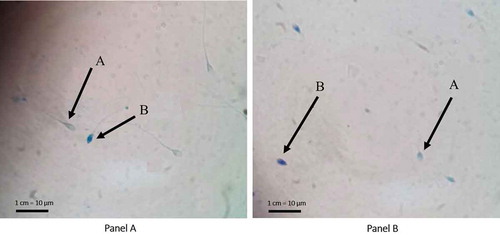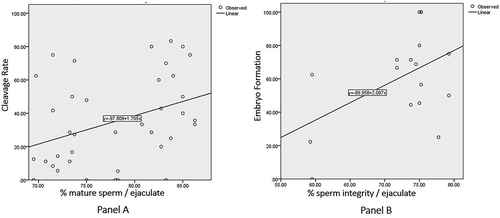Figures & data
Figure 1. Aniline blue (AB) and toluidine blue (TB) staining assay for sperm chromatin integrity analysis. (A) AB staining assay for sperm chromatin integrity analysis. A: Sperms with mature chromatin appear with unstained head (AB-negative). Mature chromatin rich in cysteine residues, cannot bind AB dye; B: sperms with immature chromatin that are rich in lysine and arginine residues bind AB and appear with blue stained head (AB-positive). (B) TB staining assay for sperm chromatin integrity analysis. A: Sperms with good chromatin integrity. The phosphate groups of DNA strands in sperms with good chromatin integrity bind just a few TB dye molecules so that the sperms’ heads appear light blue (TB-negative); B: sperms with poor chromatin integrity. TB dye bind tight to the phosphate groups of DNA strands with of sperm chromatin with poor integrity resulting in dark blue (TB-positive) sperms’ heads. Magnification 1000x.

Table 1. Comparison between sperm chromatin maturity and integrity between ICSI patients and fertile normozoospermic donors.
Table 2. Correlation analysis between sperm chromatin maturity and integrity and zygote development.
Figure 2. The correlation of sperm chromatin maturity in ejaculate of ICSI patients to cleavage rate of zygote development and the correlation of sperm chromatin integrity in ejaculate of ICSI patients to embryo formation of zygote development. (A) The correlation of sperm chromatin maturity in ejaculate of ICSI patients to cleavage rate of zygote development. There was a significant correlation between low sperm chromatin maturity, aniline blue (AB) <87% in ejaculate from ICSI patient to cleavage rate (p= 0.022; r = 0.371). (B) The correlation of sperm chromatin integrity in ejaculate of ICSI patients to embryo formation of zygote development. There was a significant correlation between poor sperm chromatin integrity, AB <80% (A) in ejaculate from ICSI patient to embryo formation (p= 0.048; r = 0.485).

Table 3. Relationship between sperm chromatin maturity and integrity.
